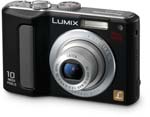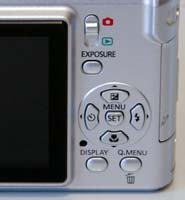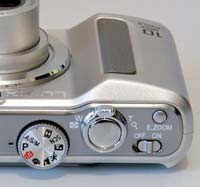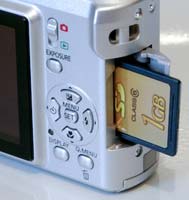Panasonic Lumix DMC-LZ10 Review
Review Date: April 7th 2008
Author: Mark Goldstein
Leave a comment about this Review
|
Introduction

The DMC-LZ10 could well prove to be the unsung hero of Panasonic's new range of Lumix cameras. It doesn't have the longest telephoto lens, or the widest, it isn't the slimmest or the lightest, and it isn't the cheapest. But the Panasonic DMC-LZ10 is definitely one of the most well-balanced cameras in the extensive Lumix range, thanks largely to the addition of Aperture priority, Shutter speed priority and Manual shooting modes. This makes the DMC-LZ10 the only consumer-oriented, affordable compact camera from Panasonic that will also appeal to the serious photographer. Only the much more expensive and ageing DMC-LX2 offers a similar degree of control. The LZ10 also has a 10 megapixel sensor, versatile 5x zoom lens offering a focal length of 30-150mm, optical image stabilizer, 2.5 inch LCD screen, face detection, and new Intelligent Auto mode for beginners. It weighs less than 150 grams and can fit in a trouser pocket. Available in silver or a more professional black for less than $250 / �170, Mark Goldstein finds out if the Panasonic Lumix DMC-LZ10 is the surprise hit of 2008.
Compare Prices
Support PhotographyBLOG: Buy the Panasonic Lumix DMC-LZ10 from one of our affiliate retailers:Ease of Use
The Panasonic Lumix DMC-LZ10 is a rather ordinary-looking, understated camera, especially in the silver finish - the black version looks much more professional. Measuring 9.75cms wide, 3.3cms deep and 6.2cms high and weighing 140 grams, the DMC-LZ10 isn't the slimmest or lightest camera around, but you can still easily carry it in a trouser pocket without noticing it. The camera body is larger and heavier than the more diminutive FX series because Panasonic's engineering team have squeezed in a wide-angle 5x zoom lens, equivalent to 30-120mm on a 35mm camera. Models of this size from other manufacturers typically have a 3x or 4x zoom lens that starts at 35mm or higher. The wide-angle lens makes this one of the more versatile compacts in terms of focal range, especially as it is coupled with Panasonic's Mega O.I.S system, which helps to ensure that the majority of photos taken in good light are sharp. If you're used to a standard 3x zoom lens which usually starts at around 35mm wide, then you will find that the lens on the DMC-LZ10 provides an entirely new angle of view that can only increase your creativity. Take it from me, you won't want to go back to a "standard" zoom after using the 30mm lens on the LZ10, especially as it also offers a telephoto setting of 150mm which is perfect for head and shoulders portraits and even some more candid shots. The LZ10's lens isn't particularly fast, with maximum apertures of f/3.3 at 30mm wide-angle and f/5.9 at the 150mm telephoto setting. Still, having a 5x zoom lens in such a small package is definitely worth having.
The DMC-LZ10 is a well-built camera, with a high quality plastic body and controls. The camera's design is dominated by the 5x zoom lens and grey plastic handgrip on the front, the 2.5 inch LCD screen on the rear, and the shooting mode dial and zoom lever on the top. There is no optical viewfinder, which follows a recent trend in digital cameras, and this does make the LZ10 a little difficult to keep steady at the telephoto end of the zoom, especially given the disappointingly slow maximum aperture of f/5.9 at the telephoto focal length. Panasonic have opted for a traditional, 5 button navigation pad, rather than the spongy joystick control of the FX-series. The shooting mode dial allows easy access to the camera's various scene, movie, automatic and creative modes, including that all-important A/S/M setting. The push-pull zoom lever sits around the shutter button and has a very responsive action. There aren't too many weak-points in terms of the DMC-LZ10's design and build-quality - for once the battery compartment and SD card slot are both well implemented. The only thing I didn't really like was the poorly-positioned tripod mount.
Despite offering a full range of both automatic and manual controls, the Panasonic Lumix DMC-LZ10 is not overly complex in terms of the number of external controls that it has, just 10 in total. The majority of the controls are clearly labeled and common to most cameras, with the E.Zoom, Exposure and Q.Menu buttons being specific to Panasonic and requiring a quick read of the user guide. Found on top of the camera are the on/off switch, zoom lever and shutter button, and the new E.Zoom button, which cleverly zooms to the full telephoto focal length at a much faster speed than normal (and then back to wide-angle with a second push). Very useful if you need to quickly zoom in on a far-away subject. On the rear of the camera is the new Q.Menu button, which is a very welcome addition as it provides quick access to most of the principal creative controls, including ISO speed, image size, image quality and white balance (there are 7 settings in total). You can still access all of these options from the main menu system too. The LZ10 offers a sensible combination of a shooting mode dial on top and a Camera / Play button on the rear to operate the various modes, which means that you can quickly and easily switch from shooting to playback without changing the shooting mode.
| Rear Controls | Top Controls |
 |
 |
The shooting mode dial is where you'll find the most interesting addition to the Panasonic Lumix DMC-LZ10, at least for photographers who desire more control - the A/S/M setting. Select this and you can then press the Menu button to choose from Aperture-priority (the default option), Shutter-priority, or Manual. Once selected, the new Exposure button on the rear of the camera toggles between allowing you to set the aperture and/or shutter speed using the navigation pad, and the navigation pad's default controls (Exposure Compensation, Flash, Macro and Self-Timer). It's not the quickest system in the world, but it is a well thought-out one given the limited space and controls on offer. Less impressive is the limited aperture range when the lens is set to the full 150mm focal length - there are just 4 apertures available (f/5.9, f/6.3, f/7.1 and f.8.0) as the camera doesn't offer any aperture values greater than f/8, whatever the zoom setting. The inclusion of Aperture-priority, Shutter-priority and fully Manual is still a real bonus that opens up all sorts of creative possibilities.
First introduced on the FX series of cameras, the DMC-LZ10 features the same version of Intelligent Auto Mode. Panasonic have tried to make things as easy as possible for the complete beginner by providing this shooting mode, which allows you to point and shoot the camera without having to worry about choosing the right mode or settings. Intelligent Auto Mode automatically determines a number of key criteria when taking a picture, including selecting the most appropriate scene mode (from 5 commonly used presets) and ISO speed, and turning face detection, image stabilization and quick auto-focus on. In practice this system works very well, with the camera seamlessly choosing the most appropriate combination of settings for the current situation. The 5 available scene modes are Portrait, Landscape, Macro, Night Portrait and Night Scenery, so obviously not all situations are covered by Intelligent Auto Mode, but it does work for the majority of the time. It makes it possible for the less experienced photographer to easily take well-exposed, sharp pictures of people, scenery and close-ups by simply pointing and shooting the camera.
As with all current Panasonic models, this camera has an anti-shake system, dubbed Mega O.I.S. Turn it on and the Panasonic Lumix DMC-LZ10 automatically compensates for camera shake, which is a slight blurring of the image that typically occurs at slow shutter speeds when the camera is hand held. There are two different modes, Mode 1 is on all the time including image composition, and Mode 2 is only on when you press the shutter button. In practice I found that it does make a noticeable difference, as shown in the examples on the Image Quality page. You don't notice that the camera is actually doing anything different when anti-shake is turned on, just that you can use slower shutter speeds than normal and still take sharp photos. Thankfully leaving the anti-shake system on didn't negatively affect the battery-life, with the camera managing an impressive 400 shots using Ni-MH batteries. The use of AA sized batteries is a real advantage if you're traveling, or you just don't want the expense of purchasing extra proprietary batteries. So long as you use the latest Ni-MH batteries, the number of picture that you can take before recharging won't be negatively affected either.
| Memory Card Slot | Battery Compartment |
 |
 |
The main menu system on the Panasonic Lumix DMC-LZ10 is straight-forward to use and is accessed by pressing the Menu/Set button in the middle of the navigation pad. There are three main menus, A/S/M Mode (if the shooting dial is set to this), Record and Setup. Most of the camera's main options, such as white balance, image quality, auto-focus mode and ISO speed, are accessed here, so the Record menu has 17 options spread over 4 screens and the Setup menu has 23 options spread over 5 screens. As mentioned previously, the addition of the Quick Menu button on the rear of the camera speeds up access to some of the more commonly used options. Due to the large LCD screen and restricting the number of on-screen choices to five, the various options and icons are very clear and legible. If you have never used a digital camera before, or you're upgrading from a more basic model, reading the easy-to-follow manual before you start is a good idea, especially as a few of the buttons are specific to Panasonic cameras. Thankfully Panasonic have chosen to supply it in printed format, rather than as a PDF on a CD, so you can also carry it with you for easy reference. The 2.5 inch LCD screen is the only way of framing your shots, so if you really have to have an optical viewfinder, look elsewhere now. I found it easy to view in all but the brightest of conditions, so don't let the lack of an optical viewfinder put you off the LZ10. The various onscreen icons used to represent the camera settings are clear and legible.
The start-up time from turning the Panasonic Lumix DMC-LZ10 on to being ready to take a photo is fairly quick at around 2 seconds. Zooming from the widest focal length to the longest is a lot slower at around 4 seconds, although using the new E.Zoom button speeds this up to less than 2 seconds. Focusing is quick in good light and the camera achieves focus most of the time indoors or in low-light situations, helped by the focus-assist lamp. The camera doesn't have any problems locking onto the subject in low-light situations. The visibility and refresh rate of the 2.5 inch LCD screen are perfectly acceptable, and the pixel count of 230,000 is fine too, with little visible grain. It takes about 1 second to store an image, allowing you to keep shooting as they are being recorded onto the memory card - there is no LCD blackout between each image. The Panasonic Lumix DMC-LZ10 has a slightly slow Burst mode which enables you to take 2.5 frames per second for up to 3 images at the highest JPEG image quality. Overall the Panasonic Lumix DMC-LZ10 is average in terms of operational speed.
Once you have captured a photo, the Panasonic Lumix DMC-LZ10 has a good range of options when it comes to playing, reviewing and managing your images. You can quickly scroll through the images that you have taken, view thumbnails (up to 30 onscreen at the same time and in a special Calendar view), zoom in and out up to 16x magnification, view slideshows, delete, protect, trim, resize, copy and rotate an image. You can also select favourite images, sort images into categories, add a text stamp and set the print order. The Display button toggles detailed settings information about each picture on and off, such as the ISO rating and aperture / shutter speed, and there is a histogram available during both shooting and playback. When taking a photo, pressing the Display button toggles between displaying the detailed information, gridlines to aid composition, and no information at all.
In summary, the Panasonic Lumix DMC-LZ10 is an unassuming but versatile digital camera that will appeal to both complete beginners and more experienced photographers looking for a pocket camera.
|
![]() PhotographyBLOG
is a member of the DIWA
organisation. Our test results for the Panasonic Lumix DMC-LZ10 have
been submitted to DIWA
for comparison with test results for different samples of
the same camera model supplied by other DIWA
member sites.
PhotographyBLOG
is a member of the DIWA
organisation. Our test results for the Panasonic Lumix DMC-LZ10 have
been submitted to DIWA
for comparison with test results for different samples of
the same camera model supplied by other DIWA
member sites.
